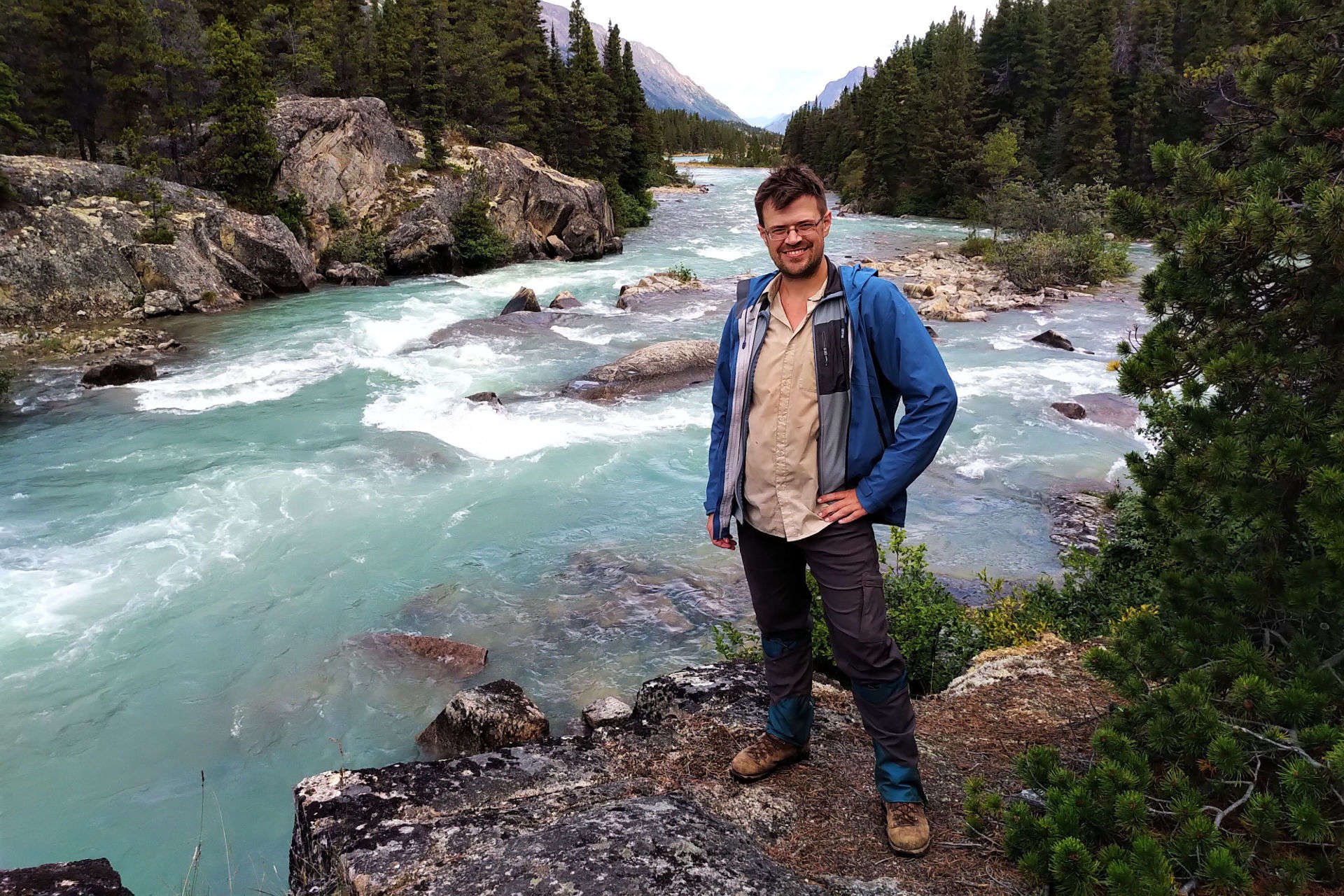It is less than 30 miles from the town of Healy, Alaska to the trail crossing of the Sushana River. It starts easily, on state highway 3, but going down the old Stampede Trail is at least moderately rigorous. An old road, mostly unmaintained, overgrown, and sometimes flooded, with bridges washed out. There are better trails, and you want a good degree of backcountry experience to hike it, but it’s far from bushwhacking.
Thirty miles in a day is an extreme, but human, hiking target: given summer weather, sufficient water, a pack loaded to the survival level, a long day before the sun set, and the maximum possible motivation, an experienced hiker would do it if his life depended on it. Taking a night on the way, it becomes reasonable in ordinary terrain. Thirty miles on foot is not inherently far. Through a burned and blown-down monstrosity of an ex-trail, thirty miles is a nightmare, but over a trail that is flooded, unmaintained, but gets fairly extensive use from ATVs and which one has hiked before, it will not be a problem.
Those paragraphs will be weirdly parenthetical to some and obvious to others. Yes, this is about Chris McCandless, aka Alexander Supertramp, who died in a disused bus-turned-shelter on the Sushana River in August 1992 and became an international celebrity.
McCandless did the hard part. He hiked to the Sushana from the highway in April, while the trail was snowbound and even the days were cold. He lived for over two months off an infamous ten-pound bag of rice and his .22 Remington. Then, come summer, he couldn’t get out. He did not commit suicide, which is willful self-murder: he tried to return, was unable to, and died, leaving final words that any of us would envy. Many have taken him as an example, and many have called him a kook, and one group is more right.
What thwarted McCandless’s escape attempt was the Teklanika River. As any mountain backpacker knows, glacial-fed rivers are hardest to cross in the early summer, when runoff and glacial melt bring them to their highest level, and by all accounts the Teklanika is a beast which some prefer to pack-raft rather than ford. Yet also, as fans of the story know, there was a cable car a half-mile downstream that McCandless didn’t find. He didn’t know it was there because, as part of his self-imposed challenge, he didn’t have quality maps. However, when a hiker must at all costs cross a raging river, that hiker scouts the banks for a crossing. Half a mile is not far. Had he treated the Teklanika River as a must-cross, and searched as hard for a ford as the ordinary hiker would have, McCandless would have tripped over the fucking cable car. Or had he camped a night and waited for morning, glacier-fed waters would be lower and he could take a better shot. McCandless had genuine outdoors experience and the arts of river crossings are not trade secrets. So was he suicidal or stupid or what?
The one thing all first-person accounts of Chris McCandless agree upon is that he may have been overconfident and self-absorbed, but he was not stupid. He had considerable experience surviving hard times on short commons in the continental 48 before he tried it in Alaska. His itinerary took him less than 30 miles of trail from town with one major ford. It hardly compares to stories of people being flown into the backend of the bush without a radio and forgetting to arrange a pickup, or rampaging through the desert weeks from civilization. Barring disaster, a fit, experienced young man could almost count on being able to hike out of trouble, and this fact, which speaks well of McCandless’s realism, is often used against him. “He died there?!” Yes he did.
Looking back on it, McCandless’s meeting the Teklanika looks like life or death. Cross it he lives, don’t cross it he dies. We know what happened. Dropped into his cheap hiking boots that July afternoon, with knowledge of the cable car excised from our brain by lasers, we’d have scoured the shore for a decent crossing. We would have waited until morning and gone for it come what may. We would have been desperate, but as so often happens context spoils a black-and-white picture.
How do we know McCandless didn’t feel desperate? Because, rather than do any of those things, or even (as an idiot would have) try to ford the Teklanika at any hazard where the trail crossed it, he turned around, and went back to his bus to wait it out.
Allow, for a moment, that McCandless’s lack of a quality map was a deliberate part of how he traveled and a risk he consciously preferred to run1: to McCandless in that moment, the raging Teklanika was merely an obstacle. The published excerpts from his diary make it clear that he was basically comfortable back in his bus, though hiking out was his preference. Every week in camp would lower the water and reduce the hazards of the ford. He was in sufficiently good condition to hike back and wait rather than act desperately and even if an emergency did strike, he was within a fairly popular area, on-trail, at the most obvious of landmarks, and chances were someone would stumble upon him in time. Which two parties, infamously, nearly did.
In that situation, with nowhere to go and nothing to do once he got back to civilization, retiring to the bus for a couple weeks was not bad strategy. He had been happy through the lean months; even two more weeks would give him an easier ford and that much less time in the civilized rat race he hated so.
Then, of course, it all went wrong and he died, emaciated, in his sleeping bag, to be found by September hunters, and the rest is history.
In the wake of Jon Krakauer’s Into the Wild and its film adaptation, too many would-be pilgrims forded, or attempted to ford, the Teklanika on their way to the “Magic Bus,” triggering so many search-and-rescue responses that the Alaska Air National Guard eventually removed the infamous bus by helicopter. According to the best reporting one hiker, 29-year-old Swiss woman Claire Ackermann, died. Those who got into trouble were by and large from Europe and southeast Asia, where stiff river fords are rare. In the most literal sense they did not know what they were getting into, and one feels for Ackermann and the more fortunate evacuees who left with nothing worse than a collection of nightmares. “How hard could it be?” Really hard, if you’ve never done anything remotely like that before, if you don’t know how best to do it, or you just get unlucky. Those rookies did not turn around as McCandless did.
Yet hundreds attempted the round trip and the great majority succeeded. In quite another context, the Outside article by Diana Saverin quotes Alaska bush expert Andrew Pace saying, of McCandless:
There are so many success stories. It just makes me mad that one about a failure is so famous.
Prominent among the success stories are those who, inspired by Hollywood, attempted to retrace the failure’s steps. The same article tells of wildly unprepared hikers with no experience who forded the Teklanika both ways and saw the bus just fine. That’s just how it goes out there. McCandless was no tyro, and Krakauer’s book describes more outlandish risks McCandless took that came through. It was simply not in God’s plan for him to survive this one.
McCandless was, in the plainest sense, incompetent, in that he bit off a big bite and it was more than he could chew. A scion of industrial society, he failed to realize the extent to which his previous survival feats had simply drawn down reserves he’d accumulated in civilization. Seed poisoning, which probably killed McCandless, is a bad week for a healthy man and death to the malnourished; rabbit starvation, where you burn 500 calories catching and digesting 400 calories, can be rather pleasant while you have excess fat and fatal once you don’t. These facts, so simply stated in a paragraph, gain weight rather than lose it from the quibbling that’s surrounded McCandless’s actual cause of death in the past thirty-two years, as well-worn ATV veterans say that “everyone knows” something they turned out not to quite understand. Many things are obvious once they’re pointed out. Hereditary Beltway elite and counter-cultural loner Chris McCandless should have learned every esoteric fact about long-term backcountry survival in 1994 by searching on Prodigy or hammering his university library when he just wanted to go outside, I suppose.
Chris McCandless plunged into an Alaska spring to live by his wits and was fine into July, so fine that he saw a nasty river crossing and said “I’m going back” rather than take desperate alternatives, and then he was dead. He was within 48 hours of self-rescue under normal conditions, and had fair odds of being found by chance; off the grid but hardly off the map. His fatal flaw was not realizing that, once your town-nourished reserves are burned off, very big problems can come very quickly.
The details of what got him are irrelevant. The debate over whether he was a tragedy or a plain idiot is essentially over whether he could have reasonably foreseen whatever got him, but nobody denies he took big risks. That was what he meant to do. Those of us who go into the backcountry across little-walked routes for 14 nights take risks too, if smaller ones: a difference of degree, not of kind. In any event McCandless, corpse and all, comes out miles ahead of those who hike up a mountain they saw on Instagram and call for search and rescue because the sun’s down and they’re hungry and lost and their feet hurt, stories so common as to be forgetable. In an era before pocket-sized GPS beacons McCandless couldn’t hit the Big Button and call for help, but at the same time he hadn’t got himself so far into the wild that any kind of healthy male wouldn’t expect to be able to hike it out as a matter of course. Less than thirty miles of trail that he had navigated before separated him from safety, and it was summer. That’s within the range where you’ll expect to get there eventually even if you break a leg.
Several times, I have been chatting to fellow backcountry hikers and Into the Wild came up. We’d all read it. The Jon Krakauer cult has taken fifteen or twenty nasty bumps over the years, but as an outdoorsman popularizing that world with Into the Wild, Into Thin Air, and earlier articles collected in Eiger Dreams, he did everyone a service even if he said a million things that need correcting. Which he did.
The tragedy of Chris McCandless’s life only seems like tragedy because his accomplishments suited him for greatness. He had a bigamous, domineering father, controlling others by unfair means long before he learned to master himself. A prosperous upbringing was wasted in the stultifying Washington, D.C. swamp-prosperity that produces only cancers rather than children of merit. Yet by his example, perhaps because of his untimely death, McCandless has been a real, physical, get-out-and-do-something-healthy-to-body-and-soul inspiration to thousands.
Had he lived, McCandless would be 55 in a month. He was born the same day as actor Josh Brolin, another nepo baby of the American machine who is even more famous than McCandless but who has never done anyone as good a turn as inspiring him to spend one night in a tent, far from the city lights, relying not on trail angels and social media clout but himself, his preparation, and his wits, living not for the ‘gram and the trail fam, but for the experience. There are probably a dozen Chris McCandlesses in the world, in their mid to late fifties, who we haven’t heard of because they don’t self-promote, they don’t have books or YouTubes or stupid hiking blogs, and they didn’t die romantically.
But he died hurr durr stupid. Chris McCandless did not die an idiot, bumbling like Mr. Bean into who-knows-where and waiting for the bright red helicopters, but because he tried to surpass the limitations of his agonizingly industrialized upbringing. He succeeded. He wanted to find spaces of the map that were unknown, so he made sure he didn’t know them; he wanted to escape the worldly preoccupations of his earthly father and heart-of-the-empire upbringing, and to go by his diary he pulled it off. He didn’t want subscribers on Patreon or even website readers, and until Jon Krakauer dug him up his story was told only in person or by letter to those he cared about. He left this world young, aged only 24, leaving a picture of him content in front of his bus and the words:
I HAVE HAD A HAPPY LIFE AND THANK THE LORD. GOODBYE AND MAY GOD BLESS ALL!
If you knew you were going to die in four days, could you leave such an epitaph? That photo stands at the top of Chris McCandless’s Wikipedia page. He doesn’t look ecstatic, like a drug addict or a wild man; he looks chill, low-key pleased with legs casually crossed, in the face of certain death. He knows he’s lived a short life but a good one. This was a pre-digital camera age. McCandless could be fairly confident that photo would be developed when his body was found, but not certain; so many things could go wrong. Of course he had no idea anyone outside the police and his family would ever see it, let alone how far his story would spread and how many hearts he would inspire.
A young man, thrust by his own hands into dire straits, never stopped fighting to live but also never lost perspective on the important things that brought him out there. He blundered, though less badly than some seem to think. He shouldn’t have gone into the Alaska bush with ten pounds of rice and a squirrel rifle, but having done so he survived far better than the ordinary book reader or film watcher. He should have known how to preserve big game and maybe he ought to have scoured the scholarly papers for what plants might let him down in the desperate nutritional crunch of hunter-gatherer life. He made mistakes that proved fatal.
Very well. Avoid those mistakes, but he was no lunatic rushing way out of his depth. If we could copy his earnest desire to avoid the sin of the world, and his courage when his luck ran out and his innings were closed, what men we would be.



